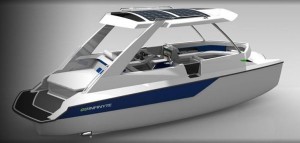Living off the grid and reducing your energy dependence doesn’t mean you need to remove all luxuries from your life. You can power your home using solar, wind, or water power, and you can run a car off of electricity, or on biodiesel fuel or vegetable oil. Well, watercraft have also kept pace with this progress, and it’s now possible for you to own and operate a solar-electric or hybrid-powered boat.
Most solar-electric watercraft are small and operate entirely on power derived from solar energy, making them run silently through the water. For example, the Loon is a pontoon boat designed for eight passengers, and it is entirely powered by solar-electric. The boat’s canopy is covered by custom-designed solar panels. The boat’s batteries allow for operation on cloudy days, and it can be plugged in at home or at the marina to quickly recharge at night.
 Infinyte Marine offers an electric cruiser with a maximum capacity of five people and an estimated run time of 10 hours before the boat’s battery needs recharging. The company’s I4 has a unique steering system consisting of a joystick rather than a traditional steering wheel or rudder control, and it has a maximum speed of around 13 knots (roughly eight miles per hour). The boat has an onboard charger, but is designed to fully and quickly charge from a traditional 240-volt outlet. While the boat itself does not have a solar panel array, you can add waterproof panels to the boat to provide additional electricity, or you can charge it at home from your off-the-grid power source.
Infinyte Marine offers an electric cruiser with a maximum capacity of five people and an estimated run time of 10 hours before the boat’s battery needs recharging. The company’s I4 has a unique steering system consisting of a joystick rather than a traditional steering wheel or rudder control, and it has a maximum speed of around 13 knots (roughly eight miles per hour). The boat has an onboard charger, but is designed to fully and quickly charge from a traditional 240-volt outlet. While the boat itself does not have a solar panel array, you can add waterproof panels to the boat to provide additional electricity, or you can charge it at home from your off-the-grid power source.
Without traditional boat engines, electric boats are nearly silent and they are excellent choices for those who enjoy fishing or relaxation. These boats are designed to take advantage of the lack of traditional power systems, and are much lighter than gas-powered boats. This makes for easier transportation and carrying, but the lack of weight can be a problem on extremely windy or stormy days. Make sure to properly secure your electric boat to keep it from being tossed around or damaged in extreme weather conditions.
 Infinyte is also developing a larger boat that will have its own integrated solar panels. Tentatively dubbed the I8, the boat will have a maximum speed of 32 knots and will be able to seat 10 people. The current design supplements solar power with a biodiesel generator in case of inclement weather or for longer-duration trips where the battery may run low before it’s possible to fully recharge it.
Infinyte is also developing a larger boat that will have its own integrated solar panels. Tentatively dubbed the I8, the boat will have a maximum speed of 32 knots and will be able to seat 10 people. The current design supplements solar power with a biodiesel generator in case of inclement weather or for longer-duration trips where the battery may run low before it’s possible to fully recharge it.
Along with personal watercraft, various companies have developed a number of public transit and commercial maritime solar applications. SolarLab developed and produced three solar-powered shuttles that are in service on lakes in the UK, Germany, and Switzerland. The carrying capacities of the boats range from 42 to 120 passengers depending on length, and the shuttles have a top speed of 15 knots.
The Sun 21 Solar Boat set a Guinness World Record for being the first boat to make a transatlantic crossing running entirely on solar power. The 14-meter-long boat (roughly 46 feet) made the crossing in 29 days and maintained a constant speed of 5-6 knots, which is roughly equivalent to the speed of the average sailing yacht. The design looks like a cross between a catamaran and a party boat, and solar panels cover the roof of the ship and provide its power.
Another notable maritime alternative energy system involves the addition of Sun Sails on cargo and passenger ships. Sun Sails, developed by Solar Sailor, collect a combination of wind and solar power to offer renewable energy to ships. The photovoltaic sails are 30 meters long (roughly 98 feet), and can be angled to collect the maximum amount of wind or solar energy. The company estimates that Sun Sails can reduce fuel costs by between 20-40%, and that Sun Sail will pay for themselves within four years.
A final mention goes to Solar Sailor’s solar catamaran. This large vessel has top structures resembling wings, which can be angled to collect power from both wind and solar sources. The catamaran can also operate on fossil fuels in dangerous wind conditions or when the ship is unable to collect sufficient wind and solar power for its operation.
These boats and ships are only a small sample of watercraft powered by alternative energy. From the traditional sailboats of yesterday to today’s solar-powered catamarans, there are multiple options available to anyone who enjoys being out on the water but who doesn’t wish to continue paying high prices for petroleum-based fuels.
 Off The Grid News Better Ideas For Off The Grid Living
Off The Grid News Better Ideas For Off The Grid Living



